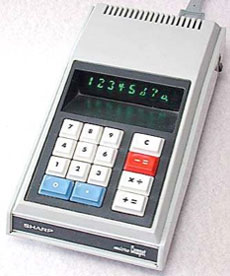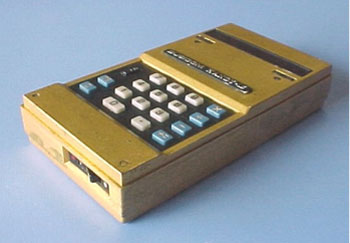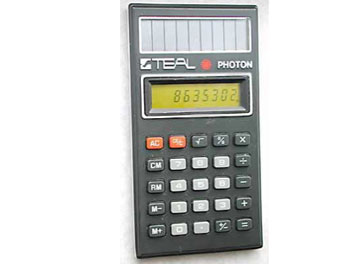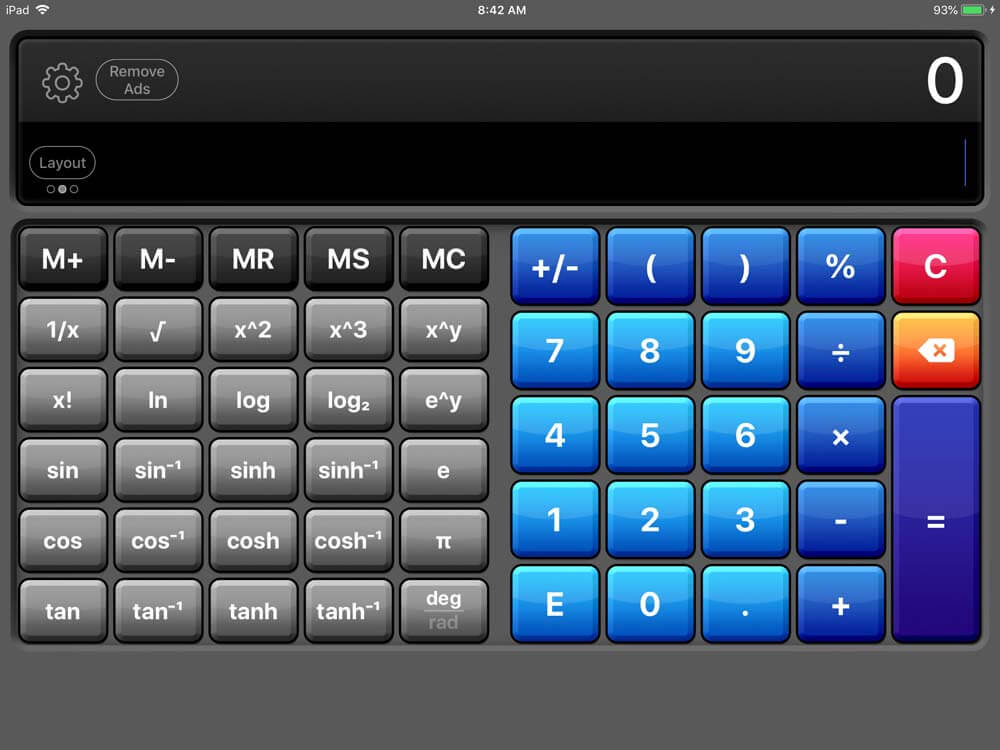The History Of The Calculator
If you need an illustration of the accelerating speed of technological change, look no further than the electronic calculator, that modest little device that does the most complex sum instantly and that you hold in the palm of your hand.
Or more likely don't anymore... for the pocket calculator, which took more than four millennia to evolve and only reached its current form in the 1990s, is already obsolescent, if not actually obsolete.
Calculation beginnings: The mechanical age
In the very beginning, of course, was the abacus, a sort of hand-operated mechanical calculator using beads on rods, first used by Sumerians and Egyptians around 2000 BC.

The Abacus: Bean counter's friend
The principle was simple, a frame holding a series of rods, with ten sliding beads on each. When all the beads had been slid across the first rod, it was time to move one across on the next, showing the number of tens, and thence to the next rod, showing hundreds, and so on (with the ten beads on the initial row returned to the original position).
It made addition and subtraction faster and less error-prone and may have led to the term 'bean counters' for accountants.
But that was where the technology more or less stuck for the next 3,600 years, until the beginning of the 17th century AD, when the first mechanical calculators began to appear in Europe. Most notably, the development of logarithms by John Napier allowed Edward Gunter, William Oughtred and others to develop the slide rule.
The slide rule is basically a sliding stick (or discs) that uses logarithmic scales to allow rapid multiplication and division. Slide rules evolved to allow advanced trigonometry and logarithms, exponentials and square roots.
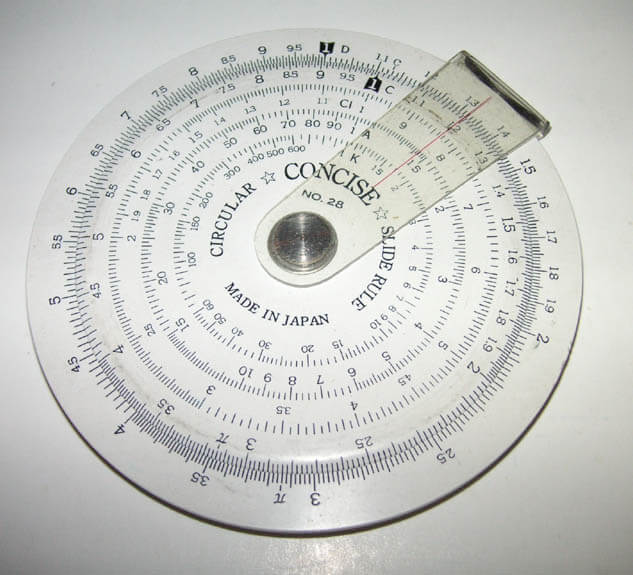
Even up to the 1980s, knowing how to operate a slide rule was a basic part of mathematics education for millions of schoolchildren, even though by that time, mechanical and electric calculating machines were well established. The problem was that these weren't portable while the slide rule fitted into the breast pocket of your button-down shirt.
Real Rocket Scientists used slide rules to send Man to the Moon - a Pickett model N600-ES was taken on the Apollo 13 moon mission in 1970.
Gears, wheels and buttons
The first mechanical calculator appeared in 1642, the creation of French intellectual and mathematics whizz kid Blaise Pascal as "a device that will eventually perform all four arithmetic operations without relying on human intelligence."
Pascal's machine used geared wheels and could add and subtract two numbers directly and multiply and divide by repetition. Gottfried Leibniz then spent the best part of his life designing a four-operation mechanical calculator, based on his ingenious slotted 'Leibniz wheel,' but ultimately failing to produce a fully operational machine.
That had to wait until 1820 and the patenting in France of Thomas de Colmar's four function Arithmometer.
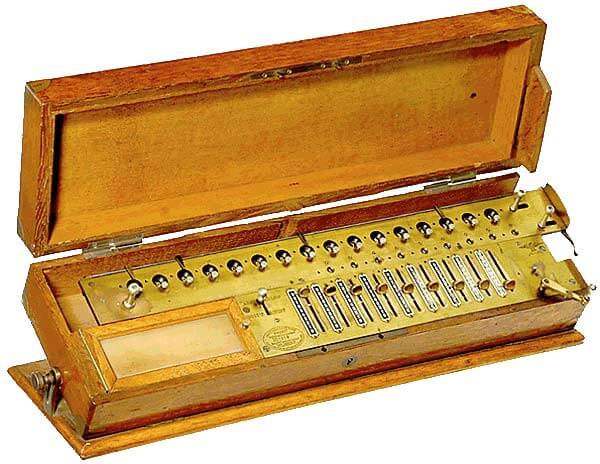
The Thomas Arithmometer Arithometer. Photo credit: The University of North Carolina
This first commercially viable counting machine was manufactured from 1851 to 1915 and copied by around 20 companies across Europe. If you want to see it working, here's a video...
By then, the main tide of innovation had moved across the Atlantic, with the development of hand cranked adding machines like the Grant Mechanical Calculating Machine of 1877 and, more famously the P100 Burroughs Adding Machine developed by William Seward Burroughs in 1886.
This was the first in a line of office calculating machines that made the Burroughs family fortune and enabled the son, William S. Burroughs, to pursue a career consuming hallucinogenic drugs and writing subversive novels like 'The Naked Lunch'.
A further step forward occurred in 1887 when Dorr. E. Felt's US-patented key driven 'Comptometer' took calculating into the push button age. This machine, too, spurred a host of imitators. The Comptometer Model ST, featured below, was introduced in the 1930s.

The Curta calculator, which first appeared in 1948, was perhaps the ultimate expression of the mechanical calculator, so compact that it could, somewhat lumpily, fit into a pocket and was capable of addition, subtraction, multiplication and division.
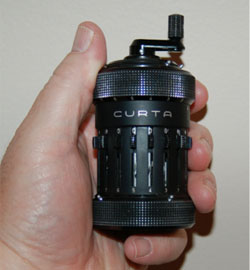
Machines like this ensured that mechanical calculators dominated 20th century office life all the way through to the late 1960s. By then, electronics were beginning to take over, as we shall see in the next part of this series.
Business calculator: The electronic age
The story of the electronic calculator really begins in the late 1930s as the world began to prepare for renewed war. To calculate the trigonometry required to drop bombs 'into a pickle barrel' from 30,000 feet, to hit a 30-knot Japanese warship with a torpedo or to bring down a diving Stuka with an anti-aircraft gun required constantly updated automated solutions. These were provided respectively by the Sperry-Norden bombsight, the US Navy's Torpedo Data Computer and the Kerrison Predictor AA fire control system.
All were basically mechanical devices using geared wheels and rotating cylinders, but producing electrical outputs that could be linked to weapon systems.
During the Second World War, the challenges of code-breaking produced the first all-electronic computer, Colossus. But this was a specialised machine that basically performed "exclusive or" (XOR) Boolean algorithms.
However, it did this using hundred of thermionic valves as electronic on/off switches, as well as an electronic display.
The application of this technology to the world's first general calculating computer had to wait until 1946 and the construction of the ENIAC (Electronic Numerical Integrator And Computer) as a completely digital artillery firing table calculator also capable of solving "a large class of numerical problems", including the four basic arithmetical functions.
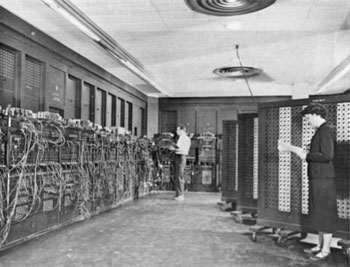
ENIAC: less processing power than a non-smart phone.
ENIAC was 1,000 times faster than electro-mechanical computers and could hold a ten-digit decimal number in memory. But to do this required 17,468 vacuum tubes, 7,200 crystal diodes, 1,500 relays, 70,000 resistors, 10,000 capacitors and around 5 million hand-soldered joints. It weighed around 27 tonnes, took up 1800 square feet of floor space and consumed as much power as a small town. Not exactly a desktop solution.
Valve and tube calculators
Electronic calculating for the office had to wait on the miniaturisation of valves and the development of solid-state transistors.
The first step was seen in 1961 with the arrival of ANITA (A New Inspiration To Arithmetic/Accounting). This was the world's first all-electronic desktop calculator and it was developed in Britain by Control Systems Ltd., marketed under its Bell Punch and Sumlock brands.
ANITA used the same push button key layout as the company's mechanical calculators, but these were the only moving parts. All of the switching was done by semiconductor diodes and cold-cathode, gas-filled valves - two Decatrons and myriad thyratrons.
The illuminated 12-place display was provided by 'Nixie' glow discharge tubes. From 1962, two models were marketed; ANITA Mk. 7 for continental Europe and the Mk. 8 for Britain and the rest of the world, with the latter soon becoming the only model. These early ANITAs sold for around £355 ($1,000), equivalent to around £4,800 ($8,000) in today's money.
Nevertheless, as the only electronic desktop calculator available, tens of thousands of ANITAs were sold worldwide up to 1964, when three new transistorised competitors appeared; the American Friden 130 series, the Italian IME 84, and the Sharp Compet CS10A from Japan.
Transistor age calculators
None of these were functionally superior to ANITA, nor cheaper (the Sharp CS10 cost around $2,500 in 1964) but their all-transistor designs opened the floodgates to a new wave of electronic calculators.
These came from the likes of Canon, Mathatronics, Olivetti, SCM (Smith-Corona-Marchant), Sony, Toshiba, and Wang.
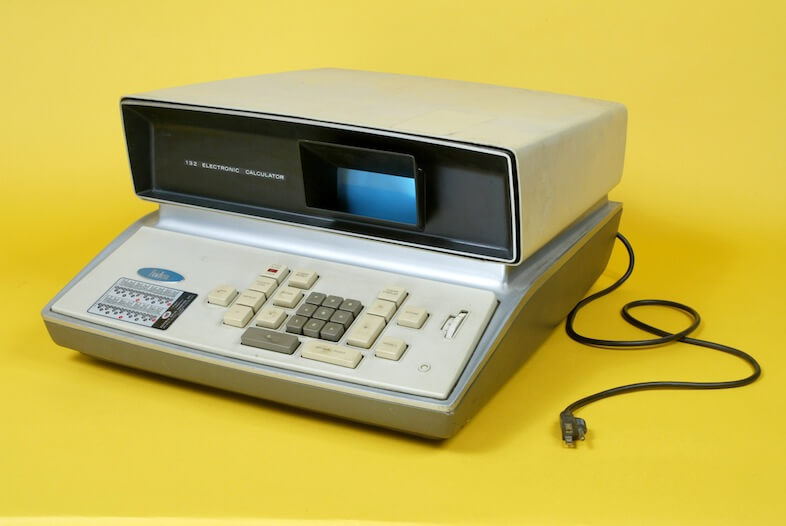
Friden calculator: First CRT display. Image credit: The Children's Museum of Indianapolis.
Four of these Beatles-era transistorised calculators were especially significant, including Toshiba's "Toscal" BC-1411 calculator, which was remarkable in using an early form of Random Access Memory (RAM) built from separate circuit boards.
The Olivetti Programma 101 introduced in late 1965 was an elegant machine that won many industrial design awards. It could read and write to magnetic cards and display results on its built-in printer.
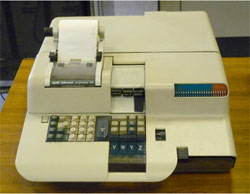
Olivetti: Programma 101: World's first PC?
As a desktop electronic calculating machine that was programmable by non-specialists for individual use, the Programma 101 could even claim to be the first personal computer.
From behind the Iron Curtain the same year emerged the ELKA 22 designed by Bulgaria's Central Institute for Calculation Technologies and built at the Elektronika factory in Sofia.
Built like a T-64 tank and weighing around 8 kg, this was the first calculator in the world to include a square root function.
All electronic calculators to this point had been bulky and heavy machines, costing more than many family cars of the period.
However, in 1967, Texas Instruments released their landmark "Cal Tech" prototype, a calculator that could add, multiply, subtract, and divide, and print results to a paper tape while being compact enough to be held in the hand.
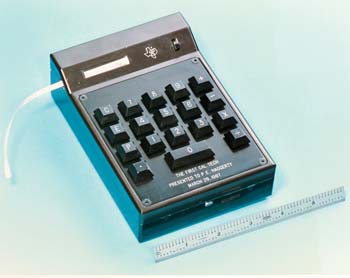
Texas Instruments 'Cal Tech': shape of things to come. Photo credit: Texas Instruments
A new chapter in the calculator story was opening...
Pocket calculator: The microchip age
It had taken 3,700 years to move from the abacus to the first mechanical calculators and a further 250 years for mechanics to give way to electronics. Yet it would take barely a decade for the calculator to make its third metamorphosis, from a heavy, bulky, expensive desktop machine that needed AC mains power to a cheap and compact battery or solar-powered device that would slip into a pocket or wallet.
To make that transition, engineers had to solve three huge principal challenges: replacing boards of transistors with integrated microchips, designing less power-hungry electronics and displays that could run on batteries and developing slimmer, simpler control mechanisms.
Texas Instruments prototype 'Cal-Tech' prototype of 1967 with its compact form was a prophet of the future, but it still used transistors and needed mains power.
Semiconductor revolution
However, within the next thee years, calculator development became the leading edge of Large Scale Integration (LSI) semiconductor development, with strategic alliances formed between the mostly Japanese calculator manufacturers and the largely U.S. semiconductor companies. Thus Canon teamed with Texas Instruments, Hayakawa Electric (Sharp Corporation) with North-American Rockwell, Busicom with Mostek and Intel, and General Instrument with Sanyo.
By 1969, a calculator could be made using just a few low power consumption chips, allowing the size and power consumption to be drastically reduced. The first of these appeared from Japan: Sharp's QT-8D Micro Compet. This used four Rockwell chips each equivalent to 900 transistors; one to power the green fluorescent display, the second to control decimal point, the third to handle digital addition and register input control and the fourth to process arithmetic and provide registers.
By modern standards this seems impossibly primitive, yet this Sharp calculator represented a great leap forward, especially when they produced an alternative model, the QT-8B that replaced the AC power supply circuitry with rechargeable cells, allowing it to be battery powered and completely portable.
Within a year, the market in 'handheld' calculators had started to take off with machines like the Sharp EL-8, Canon Pocketronic and Sanyo ICC-0081 Mini Calculator all selling briskly, despite costing the equivalent of more than $2,000 in today's money.
Pocket calculator
Yet even as they were introduced, these calculators were already obsolete. In that same year, 1970, the Japanese company Busicom released their Junior desktop model that boasted the first 'calculator on a chip' - the Mostek MK6010 that combined all four functions plus decimal point and display on one 4.6mm-square chip.
Within months, Busicom had used the same technology to produce the LE-120 'Handy' - a much smaller machine, sporting an LED (Light Emitting Diode) display, and running on four AA batteries. The pocket calculator had arrived.
Busicom also followed an interesting 'blind alley' at this time by developing a series of desktop calculators powered by the first Intel chip set arrayed around the pioneering 4004 microprocessor.
It proved overkill for the calculator so Busicom freed Intel to sell the chip-set elsewhere. As the 8000 series, it went on to drive the first generation of PCs.
The Busicom LE-120 pocket calculator was followed in late 1971 by the American-made Bowmar 901B ('The Bowmar Brain'), still a fairly chunky 1.5 inches thick, and in mid-1972 from Britain by the first 'slimline' calculator, Clive Sinclair's elegant £99 ($200) Executive, less than a centimeter thick and weighing only 70 grams.

1973 Sinclair Executive: calculator as desirable object
The main problem with these pioneering machines was that they were too expensive for most consumers (multiply prices by three to see current values).
They were also still limited to basic arithmetical functions and their LED displays drained the batteries very quickly.
Cheaper, better calculators
Within a year, Sinclair had produced the Cambridge as the first low-cost calculator, priced at £29.95 (or £24.95 in kit form). The Sinclair calculators cost far less than the competition, but had an ugly bulge in the back for the PP9v battery and with a design that frequently led to errors when doing compound sums.
Meanwhile Hewlett Packard (HP) had been developing a 'scientific' calculator. Launched in early 1972, the $395 HP-35 was an almost pocket-sized calculator with trigonometric and algebraic functions.

Hewlett HP-35: first scientific calculator
Within a few months, Texas had hit back with their own SR-10 algebraic entry pocket calculator using scientific notation for $150. The SR-11 featured an additional key for entering Pi, followed in 1974 by the SR-50 which added log and trig functions to compete with the HP-35 and in 1977 the mass-marketed TI-30 line. Slide rule sales started to plummet.
By this time, calculators had also started to become 'programmable' - accepting special inputted instructions.
Again, Hewlett-Packard led the way with their HP-65 of 1974 that had a capacity of 100 instructions, and could store and retrieve programs with a built-in magnetic card reader that also formed the label to show the new assigned functions of the transferrable F-keys.
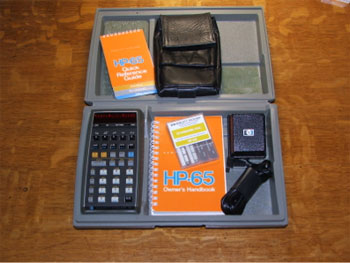
HP-65 Programmable: buying a calculator could be a Big Deal.
By 1979, HP were making an alphanumeric programmable calculator, the HP-41C, that could be expanded with RAM memory and ROM software modules, as well as peripherals like bar code readers, micro-cassette and floppy disk drives, paper-roll thermal printers, and miscellaneous communication interfaces, like RS-232.
The Soviets also produced an interesting range of Elektronika programmable calculators in the late 1970s. People managed to produce hundreds of programs for these machines, from practical scientific and business software to fun games for children. The Elektronika MK-52 calculator, featuring internal EEPROM memory for storing programs, was even used in the Soyuz spacecraft as a backup flight computer.
Subversive 'hacker cultures' grew up, dedicated to mining the undocumented "hidden' capabilities from the Elektronikas and the HP-41.
Calculator wars
Meanwhile, back in the mainstream, the struggle continued to make pocket calculators more functional and affordable. The early calculators were very expensive luxury items because they used specialised mechanical and electronic components produced in limited runs.
As the market developed, the components became commoditised and prices dropped. By 1974, the bulky TI 2550 appeared as the first sub-10 dollar calculator and within a further two years, the price of the basic 4-function pocket calculator was about a twentieth what it had been five years earlier.
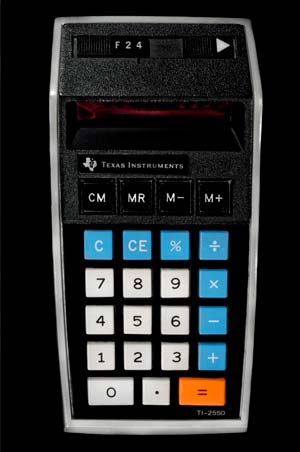
Texas Instruments TI-2550: a calculator for just $9.95. Photo credit: Curtis Perry
Good news for consumers, bad news for manufacturers whose high margins had disappeared. During the 'Calculator Wars' of the mid-1970s, most of the specialist and 'me, too' manufacturers disappeared, leaving a market dominated by five major brands: Sharp, Texas, HP, Canon and the new kid on the block, Casio.
The display was now the key technological challenge – replacing LEDs with something less power-hungry. The Liquid Crystal Display (LCD) seemed to be the obvious answer but the early LCDs were flaky and required a filament lamp for illumination, using almost as much power as LEDs. A clutch of Rockwell-sourced models were manufactured during the early 1970s under such brands as Dataking, Harden, Ibico, Lloyds and Rapid Data Rapidman, but none lasted more than a year or two.
Sharp's "COS" (Calculator On Substrate) LCD technology was better but too expensive.
By the mid-1970s, calculators were starting to use twisted nematic black on grey crystal displays, with yellow filters used at first to protect against UV.
These could be driven directly by the IC chip. At the same time, improvements to the electronics inside the calculators, using single chips and CMOS logic cells, again pioneered by Sharp in its EL-801, meant that transistors only drew power when they changed state.
The end result, by 1978, was a new generation of pocket calculators with power consumption so low that they could be driven by solar cells.
The first of these, the Sharp EL-8026, and Teal Photon, along with the credit card-sized Casio LC-78 brought the calculator close to its ultimate form as the 1970s ended.
Calculators now: The virtual age
By 1980, pocket and desktop calculators had essentially reached the forms we recognise today; compact in form, using single chips and LCD displays, operated via silicone membrane or dome switch keyboards, powered by solar cells or button batteries and capable of a wide range of functions.
Pocket calculators had also become very cheap, with some selling for as little as $1.99. Before long, companies were starting to give pocket calculators away as freebies, much as USB memory sticks are today.
By the eighties, the market was becoming saturated. Since it was hardly possible for calculators to become less expensive, they could only find new buyers by acquiring new forms and functions.
Pocket computers
The decade had barely begun when one possible route for calculator evolution appeared in the form of the amazing Sharp PC-1210 and PC-1211 'pocket computers' and their Radio Shack equivalent, the Tandy TRS-80.
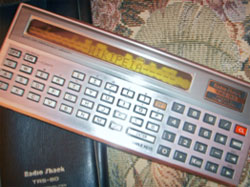
Tandy TRS-80: calculator meets computer.
By the standards of the day, these were astonishing devices; combining a calculator with a full QWERTY keyboard and 24-digit alphanumeric dot matrix LCD. They were programable in full BASIC language and, via a cassette recorder input/output and docking into a mini printer, these devices could perform almost the full range of computer functions.
However, there was no way of driving a full CRT monitor, which was a major reason, along with lack of network connectivity, why the pocket computer proved to be a technological dead-end.
Already, it was possible for the prescient to discern a faint looming threat to the calculator: the increasing prevalence, adaptability and functionality of personal computing.
However, that was still a full decade away and for the moment, the calculator was still the ultimate form of computing for most. Besides, calculating still had one or two more major evolutions up its sleeve.
Graphing calculator
One was the development of the graphing calculator, a pocket sized device that could plot graphs, solve simultaneous equations, and perform numerous other tasks with algebraic variables. Graphing calculators are also programmable, allowing the user to create customized scientific, engineering and educational applications.
By the mid-1980s, Casio was vying with Sharp, Texas and HP for dominance of the calculator market and it was they who developed the world's first graphing calculator, the Casio fx-7000G in 1985.
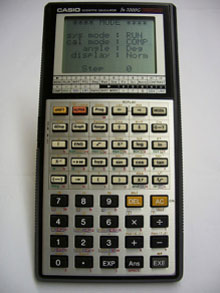
Casio fx-7000G: the graphing calculator arrives.
The fx-7000G was relatively primitive in having only an eight-line dot matrix B/W display and less than half a kilobyte of programming memory. However, it proved the concept with an enlarged display and the capability to handle 82 scientific functions along with manual computation for basic arithmetic along with a programming mode.
Unlike some of the more specialised scientific calculators, the fx-7000G employed standard algebraic notation, where calculations are entered in the conventional order, as they appear on paper. To calculate 4 multiplied by 5, you'd simply input 4 × 5 = to see 20.
This differed from the niche approach of Reverse Polish Notation (RPN), in which operands are entered before the operator, so the same calculation would be 4 Enter 5 ×. While RPN can allow for quicker calculations with fewer key presses, Casio's choice of algebraic notation kept the fx-7000G straightforward and accessible to a wider audience.
Hewlett-Packard introduced its own line of graphing calculators shortly after, starting with the HP-28 series between 1986 and 1988. This used a unique Reverse Polish Lisp (RPL) system—blending the efficiency of RPN with powerful symbolic manipulation capabilities.
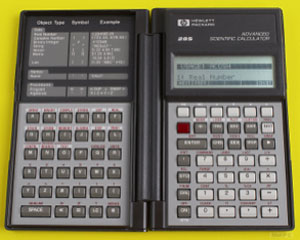
HP-28 graphing calculator: two-in-one design.
These were capable machines, sporting a flip-open "clamshell" case that paired an alphabetic keypad with a typical scientific calculator layout, along with a 137x32 LCD dot matrix display, usually displaying four lines of information and boasting four times as much memory as the Casio.
However, a design omission that had seemed insignificant in 1986 had by 1988 become a serious flaw, the lack of a computer interface for uploading or downloading data. This was addressed on the HP-48 series from 1990 onward.
The original HP-28C had a suffix denoting that it featured continuous memory. However by 1988 that was no longer remarkable, since it had become common on all serious scientific and business calculators. So in the late 1980s, HP calculators were classed "S" for Scientific, "B" for Business, and, from 1993, "G" for Graphic.
Vertical integration
Calculators were starting to go vertical - using flavored designs to appeal to specific market niches. This trend was also seen in the emergence in the late 1980s of a new player, Calculated Industries.
CI produced designs tailored to specific trades and professions. Their first machine, the Loan Arranger, was a simple to use loan amortization calculator marketed to the real estate industry.
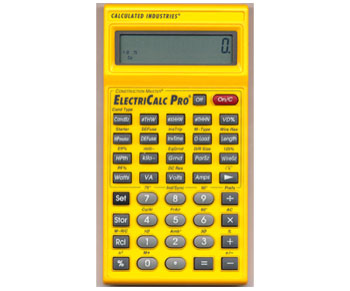
Calculated Industries ElectriCalc Pro: a calculator for electricians. Photo credit: Mark Bollman
CI has gone on to develop a wide range of other speciality calculators aimed at financial planners, contractors, carpenters, plumbers, radio and television broadcast professionals, educators, electricians, machinists, and even quilters.
Market segmentation was also seen when Texas Instruments produced its own line of graphing calculators, starting with the TI-81 in 1990.
Not only were these calculators squarely aimed at the educational market but increasingly at different segments of it.
So while TI-80 and TI-73 were aimed at junior students 10–14 years of age, other models such as TI-85 and TI-86 were aimed at senior students, with features like calculus.
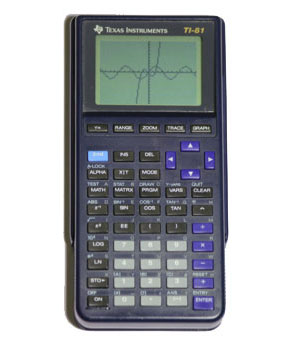
Texas TI-81: optimized for students.
More modern graphing calculators produce color outputs and animated and interactive 2D and 3D drawings of math plots, handling animated algebra theorems and preparation of documents incorporating results.
Many can function as data loggers taking inputs from digital thermometers, pH gauges, weather instruments, accelerometers and other sensors, with WiFi or other communication modules for monitoring, polling and interaction with teacher.
This has given the calculator a guaranteed presence in high school classrooms and even in exam rooms where they were formerly disallowed.
As the 80s gave way to the 1990s, new threats emerged to the calculator.
Enter mobile devices
Along with the increasing prevalence of PCs and laptops, there was the advent of smarter mobile phones.
The first hint of what was to come was delivered by the BellSouth/IBM Simon Personal Communicator of 1993.
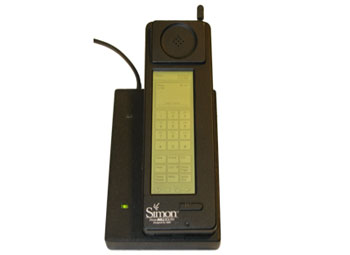
BellSouth/Simon Personal Communicator: sign of things to come.
This was a cell phone (still very chunky by today's standards) with added Personal Digital Assistant (PDA) functions including email, address book, calendar - and calculator.
In the same year, Apple's Newton PDA first made its appearance, also with a calculator function.
It was soon followed by longer-lived Palm and Handspring PDAs. By now the calculator had been relegated to the third device in your pocket, bag or case.
The threat became still more explicit in 1996, with the launch of Nokia's 9000 Communicator, a remarkable 'bells and whistles' device that bundled mobile phone with PDA functions and internet connectivity to produce one of the world's first true smartphones.
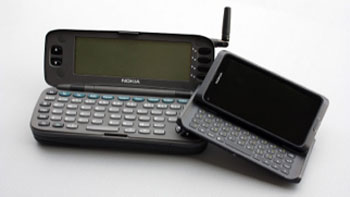
Nokia Communicators: 1990s-style smartphones.
In 2000, the Ericsson R380 did the same thing in a more compact package, confirming the trend.
The mid-2000s unleashed the deluge: the Blackberry phone (2003), followed by the touchscreen Apple iPhone (2007) and a host of Android and Windows Phone imitators. From 2010 and the launch of the Apple iPad, the idea of tablet computing first essayed in 1993 had come to fruition.
All of these devices had calculator functions embedded, not as hardware add ons but virtually in software, either as part of the original Operating System (OS) or as a downloadable 'plug in' application. And apps are unlimited - even graphing calculators or industry-specific models can be emulated in software.
Yet the world's stores and online portals still supply well over 250 different models of calculator, ranging from a couple of dollars to more than $700, for a fully featured graphing calculator.
The future
Four main factors are keeping the calculator alive. One is that designs have been successively optimised to purpose, producing a level of function and capability that even tailored apps struggle to emulate. The second is the high price of current smartphones and tablets while the third is that some people just find it easier, quicker and more precise to operate a physical device than a touchscreen.
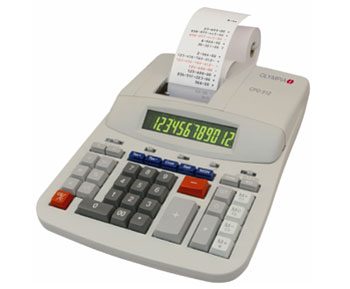
Desk Calculator: Back to the Future? Photo credit: Tsiakkas Office Solutions
Last, and arguably most important, 'dumb' calculators have over the decades earned a place in school and university exam rooms that remains closed off to 'smart' tablets and phones for the foreseeable future.
The desktop calculator, too, soldiers obstinately on, keeping its place in the office by dint of its ergonomic advantages and 'print as you go' function.
It would be ironic indeed if the humble desktop adding machine remains standing after the last sophisticated pocket calculator has found its glass case in the Museum of Doomed Technologies.
What do you think the future holds for the calculator? Which calculators have you used during your lifetime? Leave your comments below.


